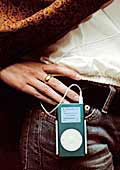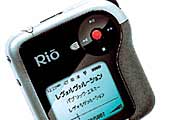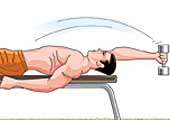 |
| All in the game: For game freaks like
Microsoft India's Mohit Anand (centre), the line between work
and play is non-existent. |
When
you think of video games, many of you think of young whippersnappers.
Kids with nothing much to do with their time but kill aliens with
weapons from the 31st century, driving the Ferrari F50 at Schumacher-esque
speeds along the French Rivera or even trying to make India win
the soccer World Cup utilising every last available resource on
their computers.
Sorry to break the cliché of video game
users, video gamers today range from three-year olds to 53-year
olds. The first generation of gamers, who grew up playing games
on the Atari 2600 (the original game console) or playing Pacman,
Dig-Dug or Test Drive on their Intel 386 PCs with monochrome monitors
are today working their way up the corporate ladder.
Of course, few have a better job than Mohit
Anand, Home Entertainment Division Manager, Microsoft India. His
job? Selling video games (among other more mundane things), and
he gets to try them out, "for free", he adds with a smirk.
"Video games are the best stress-buster. I mean, what could
be better than shooting some people up or building an empire after
a really bad day at office," is his rather compelling argument.
"Even in this office, sometimes, when someone just needs to
relax, they play a quick five minute game of pinball," he adds.
No surprises then that even at BT, when this
correspondent is summoned by the editors (a sadly much-too-frequent
occurence) he finds them playing games, in a sort of pre-emptive
stress relief operation.
On weekends, Anand, an 'Age of Empires II'
fanatic, usually invites some of his peers over for a round of gaming
over dinner. "Well we play against each other. Sometimes on
the pc, but mostly on my X-Box console," he says. His fellow
gamers are all mid-to-senior level managers in companies spanning
a whole gamut of industries. "Many people see gaming as a socially
destructive force, but I believe that gaming forms rather socially
cohesive bonds," he passionately argues. It is obvious that
this is a guy that really loves his job.
 |
| There is empirical evidence
to show that gaming helps reduce workplace stress and in forming
social bonds |
Sandeep Shetty, Project Manager, I-Energizer,
is a long-time game freak. "Games take up most of my waking
life." His current game of choice, 'Counter Strike: Condition
Zero'. "Every once in a while, I get together with my friends
at Reliance Web World stores and play games over the local network.
Its fun killing each other in the virtual world," he says.
Last year, when Microsoft organised a competition
to promote the launch of their best-selling game franchise 'Halo',
Shetty was one the people who organised it. "It was quite a
task," he points out. It must have been. Nearly 12,000 people
competed for a Rs 1 lakh cash prize and an opportunity to represent
India in the Halo world championships. Even though many were working
professionals, the top prize was snatched by 13-year old Nikunj
Bansal from Mumbai.
Rohit Kumar, Creative Director, Georapid, is
another person who considers himself to be a 'hardcore gamer'. The
28-year old who spent the better part of his last weekend finishing
off 'Call of Duty', believes games are the best way to give vent
to frustration. "Instead of keeping it inside, I take it out
on obliging Nazi soldiers," he points out. But he adds that
there are times that he even gets inspired by the games he plays.
A senior manager at Reliance Infocomm, who
declined to be named in this story (perhaps he does not want his
bosses to know that he plays games at work) is an avid gamer dabbling
in real-time strategy plays like Command and Conquer and Ground
Control, along with the occasional shooter (like Doom). "The
user experience with online gaming is very poor, we do not have
the connectivity to enjoy really good gaming like in the West; but
gaming over the Office network is very popular," he says. However,
he does point out that in a corporate like Reliance there "aren't
too many gamers as yet". Gamers, according to him, hang around
mainly in media-linked professions.
Jayant Sharma, Managing Director, Milestone
Entertainment, the distributor of Sony Playstation 2 in India, reckons
that there are over 50,000 Playstation 2 consoles in India. "There
is a definite shift in age profile. As gamers go from college to
professional careers, they carry on with their hobby."
In order to tap that market, Milestone introduced
a program called 'Playstation @ Work', where they convinced several
BPO outfits to purchase consoles for their employee rooms. "The
response to the program has been good; companies such as Wipro Spectramind,
Mindshare and L&T Infotech to name a few have purchased consoles
from us," Sharma adds. "It is not just a hypothesis. There
is empirical evidence from Western companies to show that gaming
helps reduce workplace stress and also in forming social bonds,"
he states.
As more game-addicted young folk step out of
college into the professional world, gaming will increasingly move
out from the college dorm into the boardroom.
Until then however, this correspondent will
get back to playing 'Need For Speed: Underground' where our hero
will drive his Lamborghini Gallardo through the twisted roads of
Tuscany.
TEST
DRIVE
Coolness, Colourised
 |
|
Apple iPod mini: As cool
as it gets
|
There
are few gadgets that have as intuitive a user experience as the
Apple iPod. Correction, there are no other gadgets that have such
a feel. And it looks cool to boot.
But if white is not your thing, and if you
do not have 3,000 CDs to digitise (like the Editor of this magazine
does) say hello to the younger brother of coolness-the Apple iPod
mini. Small, light and cased in a shiny blue anodised steel case,
the mini looks almost too cool to touch-like something out of the
distant future.
But, not only can you touch it, you can operate
it with just your thumb. Which is a refreshing change from needing
to have anorexic fingers to operate the latest gadgets, or other
digital music players for that matter.
The iPod mini, which was launched in January
(but in India only last week) introduced the touch scroll wheel,
an innovation that has made it onto the fourth generation iPod,
launched last month. You can store up to a 1,000 songs on the player
(it has a four-gigabyte microdrive), which you can scroll down in
less than a minute.
The innovation in Apple products is that not
only are they great to look at- I stared at the first iMac for over
half an hour-they are so easy to use that even the most technologically
challenged person can feel comfortable on them. In fact, the player
is so easy to use, that it actually makes you want to listen to
music. But great hardware can be ruined by pathetic software. And,
to put it bluntly, with all due respect to Windows Media Player
and Winamp-Apple's media player-iTunes leaves the competition far
behind. One click to transfer music from your CD to the hard drive
and another to transfer it onto the iPod. Almost idiot proof.
Of course, in the time since I have been testing
the iPod, my colleagues and my family have given up verbal communication
with me. Notch up another plus for the iPod. The only issue with
the iPod mini is its rather obscene sticker price. At Rs 20,500,
it is only Rs 7,000 cheaper than its 40-gigabyte bigger brother.
And at the same time, both are about Rs 8,000-9,000 more expensive
in India than in a friendly foreign nation.
-Kushan Mitra
THE
OTHERS
 |
 |
| Blame it on Rio: Storing
music's never been easier |
Portable
digital music players have come a long way since the first Rio Riot
jukebox came out. Initially, such players were all based on flash
memory. Flash memory players have long battery life and are small,
but are expensive and cannot store much music.
Buying preferences have recently switched to
hard drive based players, which are bigger and drain batteries fast.
But they can store immense amounts of music.
But, the competition has caught up with Apple.
Rio has come out with two new players, the Karma and the Carbon,
which target iPod acolytes with longer battery life, bigger screens
and in the case of the Carbon, a 60 gigabyte capacity. Fans aren't
convinced, however, saying that Rio has not been able to recreate
Apple's amazing interface.
Sony has also created a new hard-disc based
player the Network Walkman NW-HD1. With a name like that it can
never hope to match the iPod.
TREADMILL
PULL YOURSELF UP
 |
 |
|
A
|
B
|
Much
of the mail directed to me at musclesmani@intoday.com is from people
who want to flatten their tummies, add some muscle mass or get a
broader chest or bigger biceps. Rarely does a reader have questions
about strengthening the back muscles. That's a pity because a thick,
wide back is essential for a V-shaped torso and apart from aesthetics-I'm
told women are attracted to a man with a strong, broad back-it is
a building block for a good posture.
Ironically, the best exercises for a stronger
back are ones that many people can't do: pull-ups or chin-ups. Both
these exercises require no weights just a bar. Try it. Grab a horizontal
pull-up bar with an overhand grip that is wider than your shoulders.
Now link your feet together and pull yourself up till your chin
is above the bar. Hold for a few seconds and get back to the starting
point (See Fig. A). Repeat. How many can you do? If you're a newbie,
chances are that you'll find the going really tough. Don't despair.
Try pull-ups every day and you're sure to progress. On the other
hand, if you can do, say, just five, try to add at least one more
every day. (Hint: the number you can do depends on your body weight-after
all, you're pulling up your own weight in this exercise-and the
shape you're in overall).
The pull-up or chin-up using your own body-weight
strengthens the latissimus dorsi and teres major-two sets of back
muscles that are related. The added benefit is that the exercise
also builds your biceps. In the early days of body-building when
all those snazzy black and chrome equipment was not ubiquitous,
body-builders and athletes used their own body weight to build muscle
strength.
A big and strong back can be built by stretching
these muscles to the maximum because a stretch works a muscle through
its entire range of motion. Here's a back-stretching exercise that
can work wonders. Lie on a bench (Fig. B), with your right leg straight
on the bench and the other foot on the floor. Grab a dumb-bell in
your right hand above your thigh and keeping your arm straight,
lift it up and back through a 180-degree arc. Return to the starting
position and switch to the other arm and leg. Do four sets of eight
reps with each arm.
A little more on pull-ups: The pull-up builds
strength not only in the back muscles but also in the fingers, hands,
forearms and, as I mentioned before, the biceps. In addition-and
this is a serious bonus-the abs get a good workout because of the
stabilisation that your core abs muscles have to provide throughout
the movement. The best thing about the pull-up is its comprehensiveness!
-Muscles
Mani
write to musclesmani@intoday.com
BEATING
DIABETES
Today's
fast-paced lifestyle entailing a lot of fast food and low exercise
(walking from your car to your office and back) poses more health
risks than most people realise. Apollo Hospital's Dr. S.K. Wangnoo
says that professionals, in particular, are susceptible to diabetes,
often called a "silent killer". This is the case because
people can be unaware of having it until they develop a severe complication.
Wangnoo says regular check-ups to detect the disease early are the
only way of keeping diabetes under control.
WHAT IT IS
Diabetes is a condition in which the body does not produce or properly
use insulin, a hormone made in the pancreas. Insulin is a chemical
key that lets sugar out of the blood stream to nourish cells. When
the blood sugar level is high, it is eliminated from the body through
urination.
IF YOU MONITOR IT
Diabetes can be detected through a blood glucose test, and experts
recommend that Indians over the age of 35 with a family history
of diabetes, or other risk factors such as obesity, should get a
check-up yearly and have their blood tested on a regular basis.
Diabetes can be effectively controlled with either proper diet and
exercise, oral medications or insulin. The earlier it is detected,
the better the complications can be prevented.
IF YOU DON'T
Warning signs of diabetes include drowsiness, frequent urination,
excessive thirst or weight loss. However, patients with diabetes
who don't seek medical help face a 50 per cent increase in their
chances for cardiovascular complications. In serious cases, undetected
diabetes can lead to blindness, kidney disease and heart disease.
-Sushma Subramanian
|
